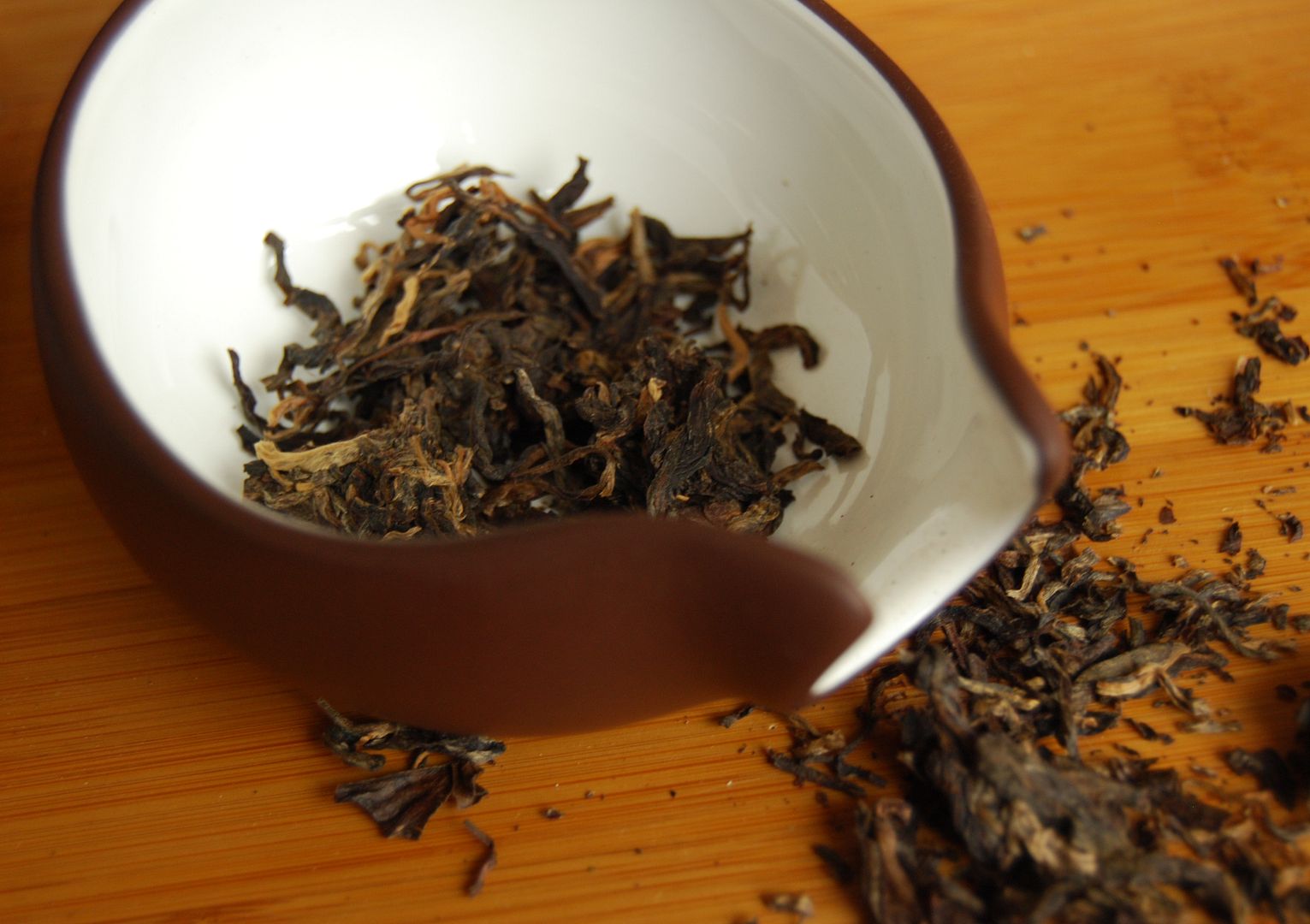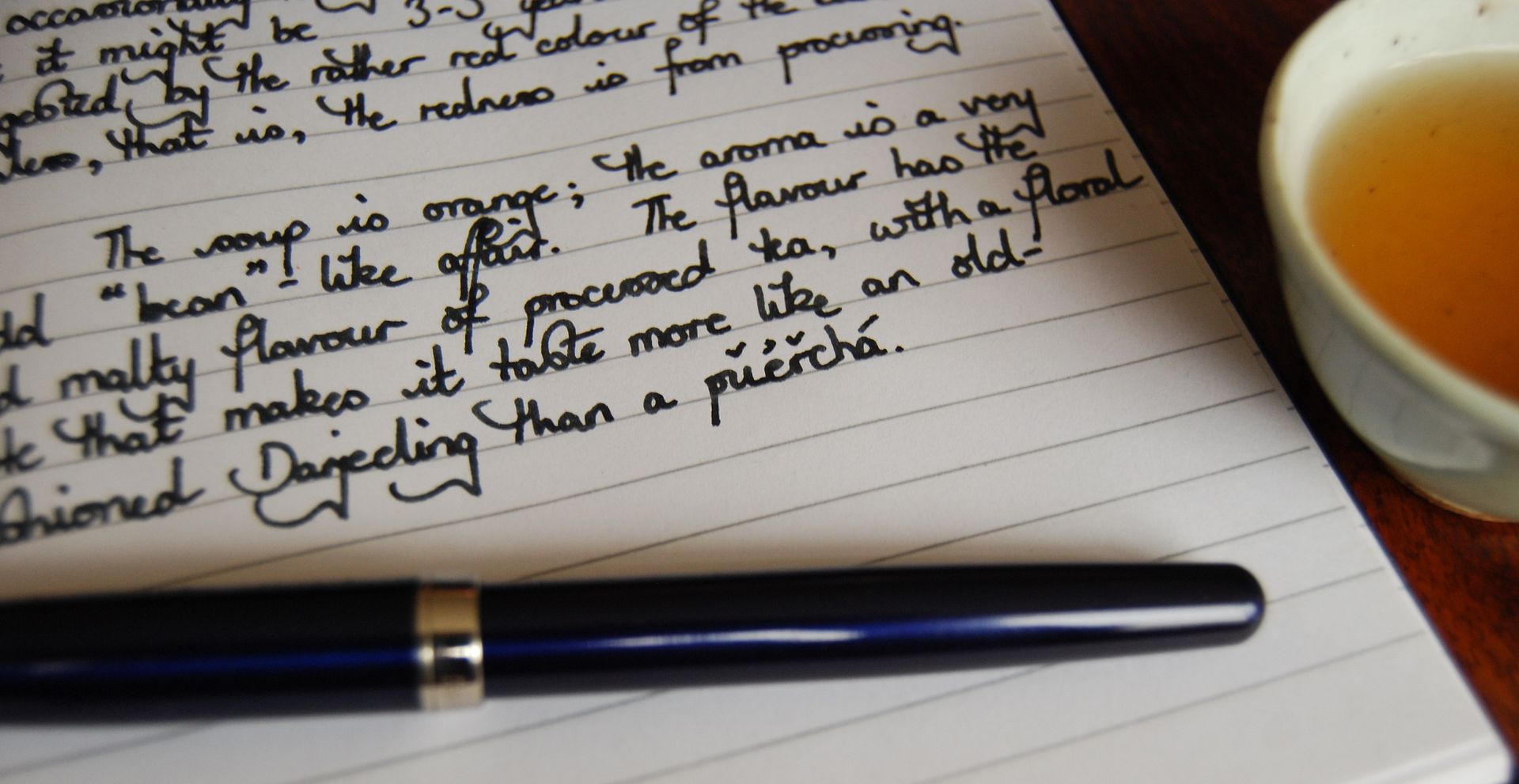"Try this blind and give me an opinion", reads the Alice-in-Wonderland-style label on a little packet that I recently received.
Twodog, of white2tea, has a habit of finding low-cost, decent cakes, as a cursory glance through the tasting notes page of this humble web-site will reveal. I am, therefore, expecting good things.
Then, it is enigmatically revealed that "This is definitely not a bargain."
First of all, consider the leaves, pictured above and below. In this instance, which is a blessed rarity, the colour balance of my camera has been accidentally set to a level sufficient to capture the colour of the leaves entirely accurately. You may conclude, perhaps, that they are more than a little bit red. This was my impression, and the photographs convey the same impression.
The age of this cake feels as it is around five years or so; the tips have a slight rustiness in their colouring, as of that age, but have not yet become entirely changed. The fragmentation is significant, as you can probably see.
The soup is orange; the aroma is a very "bean-like" affair. The flavor has the red, malty flavor of processed tea (or, more accurately, tea which has been processed "unusually"). It has a floral note that makes it taste like more like an old-fashioned Darjeeling than a pu'ercha.
As the infusions plough on, the tea develops a certain positive sweetness, but it never loses the characteristic of being thoroughly reddened. It is straightforward in texture, character, and scent, with minimal kuwei consistent with questionable processing.
However, we should not be too quick to write off this tea, whatever it may be: my journal has "While red, this mysterious sample is clean and oddly enjoyable." There is a pronounced cooling sensation, as if the inputs were once of decent quality. "There is quality, but it is buried", I seem to have written.
Mr. Dog subsequently revealed that this is a 2006 Xinbanzhang cake; that is, not "Lao" Banzhang, but the nearby eponymous village that has become increasingly more popular as "LBZ" becomes more expensive. He points to occasional flairs of brilliance that keep him hooked, mixed in with the red, fruity tea that I described.
If there is one thing I have come to conjecture about "red" teas: their deliberate lack of potency tends to result in unimpressive results some five or so years down the line. The wet leaves, shown above in my waste-water bowl, tell the story: a small portion looks green - the majority are red. This "Dr. Jekyll and Mr. Hyde" combination leaves me, similarly, in two minds.






4 comments:
I'm not sure there has to be redness. The leaves may look red when on orange wood, sure, but in the clay white-brown thingy, they look ok, for a 2006.
I think that there are two factors that may cause "redness" - first, area. I think I approximately see what you consider "red" and it seems to me that some Bulangs age that way naturally (and some Jingmais too). Similar to Darjeeling? Possibly so - but I consider it quite unlikely that it has to be some processing by producer. I think it may be just that certain areas age differently.
Second, a sort of weird "red" taste seems to appear when a tea is dry stored in high temperatures (e.g., some teas from Malaysia). Again, it is a rather "natural" process.
The idea of so many pu producers casting their evil processing magicks over tea does not fit my understanding of Occam's razor. Natural causes seem like a simpler explanation.
Best,
Jakub
The debate over "red" leaves is, surely, out of steam by now. :)
My camera is not the best at reproducing accurate shades; in real life, they really are rather red. The consequences in the character of the tea were entirely predictable as a result. The cause of the redness is a matter for speculation, but the absolute correlation between their colour and their resulting character is close to 1.0.
Toodlepip,
Hobbes
I received a sample of this and I enjoyed it very much
I found it to be nice perhaps 25% of the time, approximately in proportion to the quantity of green leaves in the blend. :)
Toodlepip,
Hobbes
Post a Comment